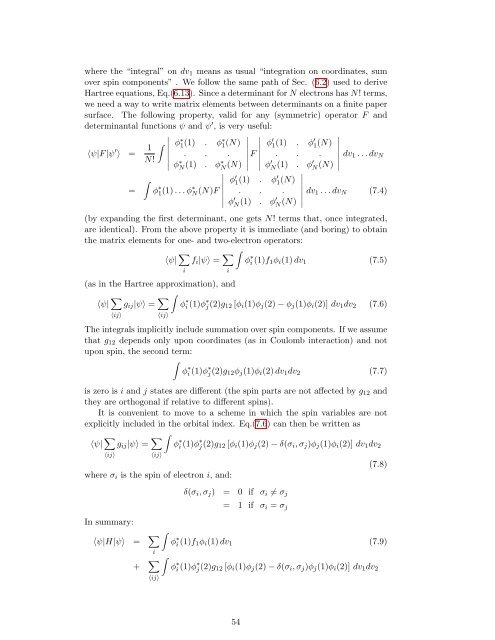Numerical Methods in Quantum Mechanics - Dipartimento di Fisica
Numerical Methods in Quantum Mechanics - Dipartimento di Fisica
Numerical Methods in Quantum Mechanics - Dipartimento di Fisica
You also want an ePaper? Increase the reach of your titles
YUMPU automatically turns print PDFs into web optimized ePapers that Google loves.
where the “<strong>in</strong>tegral” on dv 1 means as usual “<strong>in</strong>tegration on coord<strong>in</strong>ates, sum<br />
over sp<strong>in</strong> components” . We follow the same path of Sec. (6.2) used to derive<br />
Hartree equations, Eq.(6.13). S<strong>in</strong>ce a determ<strong>in</strong>ant for N electrons has N! terms,<br />
we need a way to write matrix elements between determ<strong>in</strong>ants on a f<strong>in</strong>ite paper<br />
surface. The follow<strong>in</strong>g property, valid for any (symmetric) operator F and<br />
determ<strong>in</strong>antal functions ψ and ψ ′ , is very useful:<br />
〈ψ|F |ψ ′ 〉 = 1 ∫ ∣ ∣∣∣∣∣ φ ∗ 1 (1) . φ∗ 1 (N)<br />
∣ ∣∣∣∣∣∣ . . . F<br />
N!<br />
φ ∗ N (1) . φ∗ N (N) ∣<br />
∫<br />
= φ ∗ 1(1) . . . φ ∗ N(N)F<br />
∣<br />
φ ′ 1 (1) . φ′ 1 (N)<br />
. . .<br />
φ ′ N (1) . φ′ N (N) ∣ ∣∣∣∣∣∣<br />
dv 1 . . . dv N<br />
φ ′ 1 (1) . φ′ 1 (N)<br />
. . .<br />
φ ′ N (1) . φ′ N (N) ∣ ∣∣∣∣∣∣<br />
dv 1 . . . dv N (7.4)<br />
(by expand<strong>in</strong>g the first determ<strong>in</strong>ant, one gets N! terms that, once <strong>in</strong>tegrated,<br />
are identical). From the above property it is imme<strong>di</strong>ate (and bor<strong>in</strong>g) to obta<strong>in</strong><br />
the matrix elements for one- and two-electron operators:<br />
〈ψ| ∑ f i |ψ〉 = ∑ ∫<br />
φ ∗ i (1)f 1 φ i (1) dv 1 (7.5)<br />
i<br />
i<br />
(as <strong>in</strong> the Hartree approximation), and<br />
〈ψ| ∑ g ij |ψ〉 = ∑ ∫<br />
φ ∗ i (1)φ ∗ j(2)g 12 [φ i (1)φ j (2) − φ j (1)φ i (2)] dv 1 dv 2 (7.6)<br />
〈ij〉<br />
〈ij〉<br />
The <strong>in</strong>tegrals implicitly <strong>in</strong>clude summation over sp<strong>in</strong> components. If we assume<br />
that g 12 depends only upon coord<strong>in</strong>ates (as <strong>in</strong> Coulomb <strong>in</strong>teraction) and not<br />
upon sp<strong>in</strong>, the second term:<br />
∫<br />
φ ∗ i (1)φ ∗ j(2)g 12 φ j (1)φ i (2) dv 1 dv 2 (7.7)<br />
is zero is i and j states are <strong>di</strong>fferent (the sp<strong>in</strong> parts are not affected by g 12 and<br />
they are orthogonal if relative to <strong>di</strong>fferent sp<strong>in</strong>s).<br />
It is convenient to move to a scheme <strong>in</strong> which the sp<strong>in</strong> variables are not<br />
explicitly <strong>in</strong>cluded <strong>in</strong> the orbital <strong>in</strong>dex. Eq.(7.6) can then be written as<br />
〈ψ| ∑ g ij |ψ〉 = ∑ ∫<br />
φ ∗ i (1)φ ∗ j(2)g 12 [φ i (1)φ j (2) − δ(σ i , σ j )φ j (1)φ i (2)] dv 1 dv 2<br />
〈ij〉<br />
〈ij〉<br />
where σ i is the sp<strong>in</strong> of electron i, and:<br />
(7.8)<br />
δ(σ i , σ j ) = 0 if σ i ≠ σ j<br />
= 1 if σ i = σ j<br />
In summary:<br />
〈ψ|H|ψ〉 = ∑ ∫<br />
i<br />
+ ∑ ∫<br />
〈ij〉<br />
φ ∗ i (1)f 1 φ i (1) dv 1 (7.9)<br />
φ ∗ i (1)φ ∗ j(2)g 12 [φ i (1)φ j (2) − δ(σ i , σ j )φ j (1)φ i (2)] dv 1 dv 2<br />
54
















